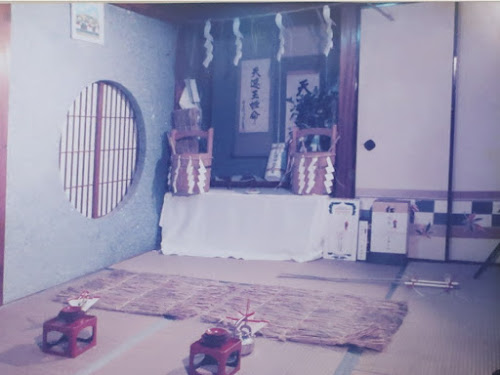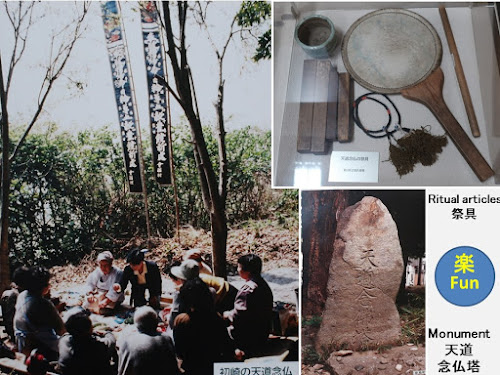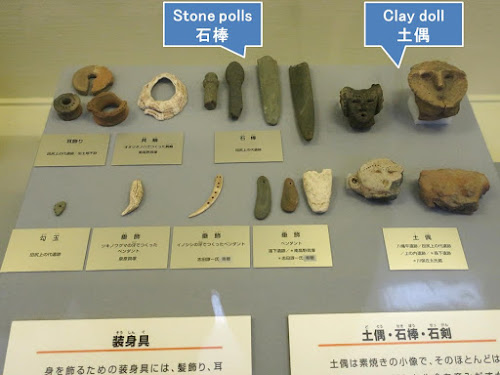This museum shows us the history, folklore and industry of Hitachi city where Hitachi Ltd. was established in 1910. There are a lot of exhibits about folklore, so we can understand the festivals, customs and everyday lives easily. For example, in a village without a priest of a shrine, people keep the deity in rotation. Interestingly enough, people are dead drunk when they handover the deity.
茨城県日立市の歴史、民俗、産業を紹介している。日立製作所の創業の地でもある。民俗の展示も充実しており、祭り、風習、生活が良く分かる。神職のない村で、神を各家に持回る時の行事では、引き継ぐ時につぶれるまで酒を飲むというのが面白い。
 |
Entrance of the 2nd
floor exhibition room: Hitachi’s people and Industry、2階展示室(日立の民俗と産業)入口
|
Festival 祭
The photo below is a model of Hitachi Furyumono which is a float with a stage to play a puppet show. It goes around the city in the Sakura cherry blossom season. It is designated UNESCO cultural heritage.
日立風流物模型。桜の季節に、山車で街を練り歩く。人形芝居をできるようになっている。参加しても、見物しても楽しみだ。ユネスコの文化財になっている。
There are four floats which are 15 meter height and five stories. Only one float is pulled usually, but all floats are pulled at the grand festival of Kamine Shrine which is held every seven years.
高さ15m、5層の山車で、4台ある。通常は毎年一台ずつ曳くが、7年に一度開催される「神峰神社大祭礼」では、山車4台が一堂に集まり、演目を披露する。
 |
| Festival in 1994、1994年の日立風流物 |
 |
Four floats at the grand festival in 1979
大祭礼(1979年)で4台揃った山車
|
 |
| Puppet show on the float、山車の人形芝居 |
 |
| Puppet show on the float、山車の人形芝居 |
Other local festivals are also exhibited. The photo below is a lion dance and its mask.
 |
| 獅子三匹が踊るささら(会瀬)とささらの面 |
Rite of handover of the divided deity of Izumi Shrine “Touya-festival” is interesting and funny. The deity rotates among the houses every year. It is a relic of the bygone age when people performed the rite by themselves, because there were no priests at the shrine.
泉神社の当屋祭。一年交代で当屋を選び、泉神社の分霊を、順送りしていく。専業の神職が居なくて、村人だけで神事を行っていた時代の名残だという。
In the room of the handover rite, straw mats are set at the successor side. The predecessors force them to drink until falling down. They bow on the floor, however, the predecessors say “Bow deeply, lower your hip” and hit them. They hit tatami mats nowadays, it is funny and ridiculous!
当屋引き継ぎの席。引き継ぐ側に蓆を敷いているようだ。当屋引き継ぎの席では、引き継ぐ側が酔いつぶれるまで酒を飲まされる。「平身低頭頭が高い、尻が高い」と鞭で打たれる(今は、畳をたたく)という。面白い!
People visit the shrine to offer thanks the next day. A lady brings two
buckets of sake (alcohol). it’s a humorous festival.
当屋祭のお礼参りでは、お神酒を入れる手桶は女性が担いで泉神社に向かうという。祭神は天速玉姫命とあるが、神様は女性好きだからか? これも面白い。Farmers’ annual events、農家の年中行事
Cocoon: A tree is decorated with cocoon-shaped rice cakes, and people pray for rich harvest on the 14th January.
Tasuke doll: People make straw dolls which have sweet buns on the 10 July by the lunar calendar. Children bring them and take other buns. They move to the fringe of a village and burn the dolls. It is a kind of rites for pest control which is called “Mushi-okuri”.
Bon boat: Children made straw boats for their ancestor spirits. They brought them to the beach, loaded sweets and floated on the 15th July by the lunar calendar. Next day, they went to the beach again, lit boats and saw them off.
まゆ玉:1月14日、木にもちを成らせ豊作を願う
大助人形:旧暦7月10日、麦わらの人形の懐に小麦饅頭を入れる。子供達は、人形を持ち寄り、饅頭を奪い合いながら遊び、集落のはずれで燃やした。燃え残りを虫除けとして辻に立てるところもあった。とある。
盆舟:田尻町では、15日に子供たちが麦わらで作った盆舟(精霊舟)を浜へ曳きだし、供物のオカエリダンゴとともに海に浮かべたという。16日早朝、盆舟に火をつけて、海に流した、という。
Straw potable shrine “Wara-mikoshi”: It is for children. The pumpkin orb on the top is very cute.
Ornament for the rice field god “Kariage”: The rice field god comes to the fields when rice planting starts and returns to the mountain on the 10th October by the lunar calendar. Farmers offer rice cakes and appreciate.
Mogami god: preventing from smallpox
藁神輿:子供用の神輿。宝珠に見立てたかぼちゃが面白い。
刈り上げ:田植の時に来てくれた田の神が山に帰るのを感謝する祭り。旧暦10月10日に行う。餅をついて供える。
モガミさま:疱瘡除けの神様。
Folk religion 民間信仰
Koushin-machi: There is the day called “Koushin” every sixty days. The insect in our body comes out from our body on this day and reports our sin to the Tentei god. People stay up all night and prevent the insect from going out. The tableware and the menu of the Koushin night are exhibited.
庚申待:60日毎の庚申の夜、体内の虫が出て行き天帝に罪過を報告するのを防ぐため、夜通し起きている。メニューなどが書かれている。金額入りだ。立派な料理のようだ。(読めるようになりたい!)
Tendou-nenbutsu: This is a kind of sun worship. People build a monument of sun, and gather. It is held before farming season. It looks like a picnic.
天道念仏:小高い山の頂や海岸部で、天道塚を築き、光明真言などを唱える。太陽を拝む。楽しい集まりだったと思う。旧暦2月、3月の行事。寒いけど、農閑期だ。
Daily goods、日常の道具
Tableware: There are big cups. When and Who used them?
日常の食器類:大杯、誰が飲むのか、いつ飲むのか。面白い。
 |
| Agricultural implements、農具 |
 |
| Agricultural implements, we can touch them. |
 |
| Farming and fishing、畑作と漁具 |
 |
| Modern industry; cupper mining、近代産業の銅鉱山 |
 |
Establishment of Hitachi Ltd., as a motor
maintenance company at the mining site、日立創業小屋、日立マンが熱くなれるところだ
|
 |
The factories were bombed three times and
1,578 people died in 1940 (WW2). 第二次世界大戦での度重なる工場の爆撃、艦砲射撃。1,578人がなくなっている。
|
Hitachi’s history、日立の歴史
 |
| 1st floor exhibition room、1階展示室 |
Excavated ritual items in the ancient period.
縄文期の祭具。石棒は男性器を模擬したものだそうだ。
Preserved bonito (fish) in salt was the specialty of this area, which helped their livelihood. These books recorded the trades.
江戸時代の特産品、鰹の塩辛に関する帳簿と道具の展示。生きる糧としての名物は大切だった。
Medical instruments in the Edo period
村医者、柴田方庵の道具(江戸時代)
Military instruments of farmers to fight with foreign warships at the end of the Edo period
幕末の海防農兵の装備
There is a turbine blade of a power plant, which is installed in front of Hitachi station as a monument. It was donated by Hitachi. Ltd.
駅前の発電用のタービン翼(最後段)のモニュメント。日立製作所寄贈。
Hitachi station is very close to the Pacific Ocean.
海に突き出す日立駅
12 funs(楽fun)were found. Visited in August, 2018
Official website: http://www.city.hitachi.lg.jp/museum/ (in Japanese), accessed in August, 2020
Previous post (Museum in the same prefecture, Ibaraki):
Next post (Farmer’s daily life in the Edo period based on his daily、千葉県吉野家の日記からみた農家の楽しみ):
Yoshino’s daily life 13, The first half ofJanuary in 1851(嘉永4年一月上旬)


















Comments
Post a Comment